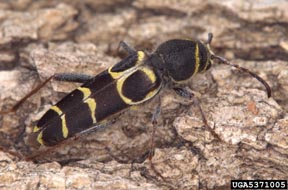Banded ash borers
Editor’s note: This article is from the archives of the MSU Crop Advisory Team Alerts. Check the label of any pesticide referenced to ensure your use is included.
The banded ash borer, Neoclytus caprea (Coleoptera: Cerambycidae) is another attractive beetle that emerges from dying ash trees. It is among the first longhorned beetles to emerge in the spring. Specimens or photos of specimens were first sent to the lab this year around the first of April.
The banded ash borer occurs in eastern Canada and throughout most of the United States. Its hosts include ash, hickory, elm, mesquite and occasionally white oak. Adult beetles resemble wasps. They are dark brown to almost black and from 1/2 to 1 inch long. The back of the beetle is marked with four yellowish bands with the first two joined along the midline to form two “loops.” Also, there is a distinct, yellowish stripe behind the head on the front edge of the pronotum. Unlike the Emerald ash borer, the banded ash borer does not attack healthy trees but instead prefers dead, dying, diseased, or stressed trees.
Adults emerge in early spring and fly to host material where they deposit eggs in crevices in the bark. Ash logs cut during the winter are especially subject to attack as are EAB attacked ash. The larvae feed under the bark for a period of time before boring into the sapwood where they feed for the remainder of the summer. Pupation occurs in the fall but the adult does not emerge until the following spring. There is usually one generation per year; however, if the infested material is sawed, stored and dried out, the life cycle may require several years to complete.
Adult cerambycids are commonly called longhorned beetles because of their long antennae. The larvae are usually called roundheaded borers and all but a few members of the family live in the tissues of trees or other woody plants.



 Print
Print Email
Email





